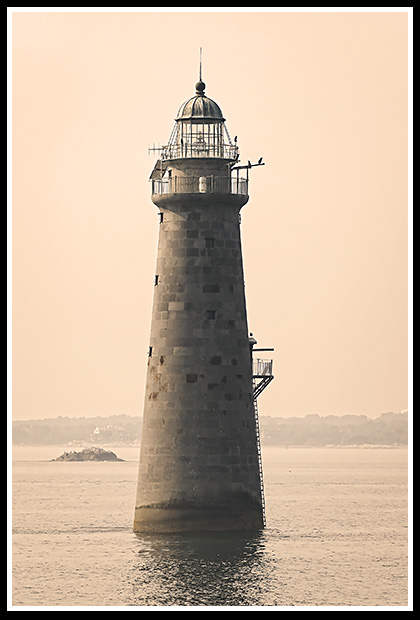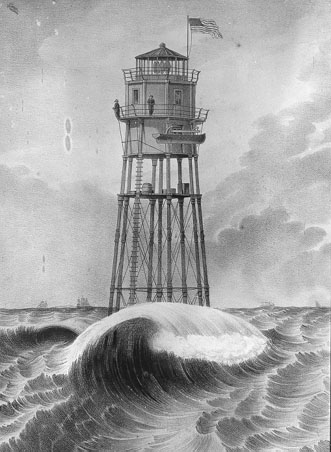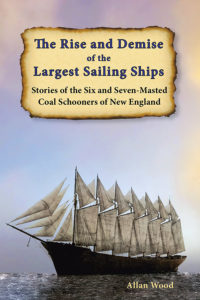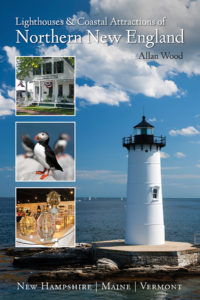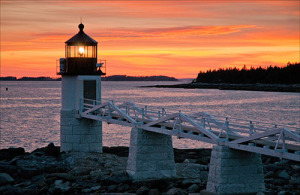Perilous Lighthouse Storm of New England: The Tragedy of Two Keepers and Destruction of Minot’s Ledge Lighthouse
Minot’s Ledge, located south of Boston Harbor in Cohasset, Massachusetts, was a destructive rocky ledge that destroyed many a vessel and claimed many lives before Minot’s Ledge Lighthouse was built there in January of 1850. It took three years to build as an engineering feat consisting of an enormous lantern perched on a huge 87-foot skeletal iron tower to protect the structure and its keepers against the strong winds and waves. The concept was that fierce winds and waves could pass through instead of constantly smashing a solid, enclosed structure, as was the construction of most other lighthouse towers.
Almost as soon as the tower was built, problems seemed to arise, with complaints from its keepers. Constant vibrations from the pounding seas and winds caused observable cracks in the locations where holes were drilled for the pillars. The pillars were becoming loosened, and on the January before the storm hit, Keeper John Bennett stated that he felt the lighthouse would not last through the winter, as he or his assistants would be thrown off their feet when heavy seas would pound on the structure. His superiors told him it was believed safe and he would stay and continue his duties at the lighthouse.
Just before the storm hit on Monday, April 14, 1851, Keeper Bennett was ordered ashore to gather much-needed supplies and had left his two young assistants, Joseph Antoine and Joseph Wilson, to manage and tend the lighthouse in his absence. Joseph Wilson was a proud sailor and was reported in March, before the storm, in response to inquiries from reporters with regards to the safety of the lighthouse, that he would stay as long as Bennett would stay and that only when they would leave the lighthouse, it would be too dangerous for anyone else to take over. Joseph Antoine was a Portuguese sailor with relatives in Cohasset and loved working at the lighthouse. The storm suddenly came upon the Massachusetts coast that Monday afternoon with a vengeance, preventing the two men from leaving their post.
By Wednesday afternoon, April 16, the seas were still surging and pounding Minot’s Ledge light. The only way to reach the shore would have been to descend the 87-foot structure down a rope outside to their small boat and battle the dangerous waves for miles to reach the mainland. An impossible task as the two had no choice but to ride out the storm and hopefully survive.
As the seas worsened, the men lit the lantern at five o’clock so that others may avoid a perilous fate. The waters swelled from the high tides, ferocious wind gusts, and torrential rains by nightfall. The brave men continued to perform their faithful duties, uncertain as to whether they would survive the night. Anxious locals observed the lantern from the shore while hurricane-force winds, recorded at over 100 miles per hour, continued to thrash at the lighthouse. The two assistant keepers managed to keep the lighthouse lamp burning as late as 10:00 p.m., as observers had recorded from shore. The fog bell continued to ring until around one o’clock that morning when the tower was swept away. It could only be imagined the anguish the two men felt as they awaited their fate and the emotional sense of loss as the tower started to give way under the pressure of the devastating waves and winds. Their cries would never be heard in their last minutes as the pillars gave way, sending the entire iron structure toppling under the waves, tossing them into their watery graves.
Around 4 o’clock on Thursday the following morning, there was a lull in the storm, and Keeper Bennett went to the beach to see if the tower was still standing. He found no evidence of the tower in sight, only the bent iron pilings where the lighthouse once stood. Plenty of debris had washed up on the shore. As he observed the debris, he found much had belonged to the lighthouse structure and keeper’s living quarters, including bedding and some of his clothing. He found two life vests washed ashore that appeared to have been used but may have been washed off their inhabitants by the angry waves.
Joseph Antoine’s body was found later that day near Nantasket Beach, and Joseph Wilson’s body was found washed on nearby Gull Island. The men have always been regarded as true heroes of Minot’s Ledge Light.
By Sunday, April 20, the storm had finally cleared away from its near week-long devastation in New England. It would take many years afterward to access and rebuild the damage caused by this fierce and destructive storm. It was later named the “Lighthouse Storm,” as it was directly responsible for the destruction of Minot’s Ledge Lighthouse.
Keeper Bennett became in charge of a temporary light ship beacon anchored just off Minot’s Ledge, where the original lighthouse stood, to replace a new lighthouse temporarily. The construction of the new Minot’s Ledge Lighthouse began in 1855 and was hailed as the most outstanding achievement in lighthouse engineering, from lessons learned from the previous ill-fated structure. The construction of the new lighthouse took time as many of the construction workers, who were only allowed on the project if they could swim, would be swept off the rocks by the constant breaking of the waves over the ledge.
Two years into the lighthouse’s construction, the ship, New Empire crashed on the dangerous ledge and destroyed most of the lighthouse. Three years later, in 1860, Minot’s Ledge lighthouse was finally completed as one of the most expensive lighthouses in history. It is still considered one of the top engineering feats of the Lighthouse Service. Antoine and Wilson are remembered each April, and many believe their spirits are still guarding the lighthouse as the Ghost Keepers of Minots Ledge light.
Exploring the Boston Harbor Area
There are no tours out to the lighthouse. Each summer, the Friends of Boston Harbor Islands offer tours out of Boston that take out to the islands around Boston Harbor. Their tours offer historical narrations and great perspective views of the importance of these beacons in protecting mariners from the many islands and ledges surrounding Boston Harbor.
Be Safe,
Allan Wood
The Rise and Demise of the Largest Sailing Ships: Stories of the Six and Seven-Masted Coal Schooners of New England. In the early 1900s, New England shipbuilders constructed the world’s largest sailing ships amid social and political reforms. These giants were the ten original six-masted coal schooners and one colossal seven-masted vessel, built to carry massive quantities of coal and building supplies and measured longer than a football field! This book, balanced with plenty of color and vintage images, showcases the historical accounts that followed these mighty ships. Stories involve competitions, accidents, battling destructive storms, acts of heroism, and their final voyages.
Available in paperback, hard cover, and as an eBook for all devices.

Book – Lighthouses and Coastal Attractions in Southern New England: Connecticut, Rhode Island, Massachusetts
My 300-page book, Lighthouses and Coastal Attractions of Southern New England: Connecticut, Rhode Island, and Massachusetts, provides memorable human interest stories from each of the 92 lighthouses, along with plenty of indoor and outdoor coastal attractions you can explore. These include whale-watching excursions, lighthouse tours, windjammer sailing tours, and adventures, unique parks and museums, and even lighthouses you can stay overnight. You’ll also find plenty of stories of shipwrecks and rescues and about heroic keepers like the two mentioned above. Lighthouses and their nearby attractions are divided into regions for weekly and weekend explorers. You’ll also find plenty of stories of hauntings around lighthouses.
My 300-page book, Lighthouses and Coastal Attractions of Northern New England: New Hampshire, Maine, and Vermont, provides memorable human interest stories from each of the 76 lighthouses, along with plenty of indoor and outdoor coastal attractions you can explore and tours. Lighthouses and their nearby attractions are divided into regions for weekly and weekend explorers. Attractions and tours also include whale watching tours, lighthouse tours, windjammer sailing tours and adventures, special parks and museums, and lighthouses you can stay overnight. There are also stories of haunted lighthouses in these regions.
Copyright © Allan Wood Photography, do not reproduce without permission. All rights reserved.
Join, Learn, and Support The American Lighthouse Foundation
d.
